Blue whales and humpback whales, while both being majestic baleen whales, showcase key differences.
Blue whales are the largest animals ever known to have existed, reaching nearly 100 feet long. In contrast, humpback whales generally max out around 50-60 feet. Blue whales have smoother bodies with tiny dorsal fins. Conversely, humpbacks have long, distinct pectoral fins and a more pronounced dorsal fin. Blue whales are known for their deep, resonating calls, while humpback whales captivate with their complex songs.
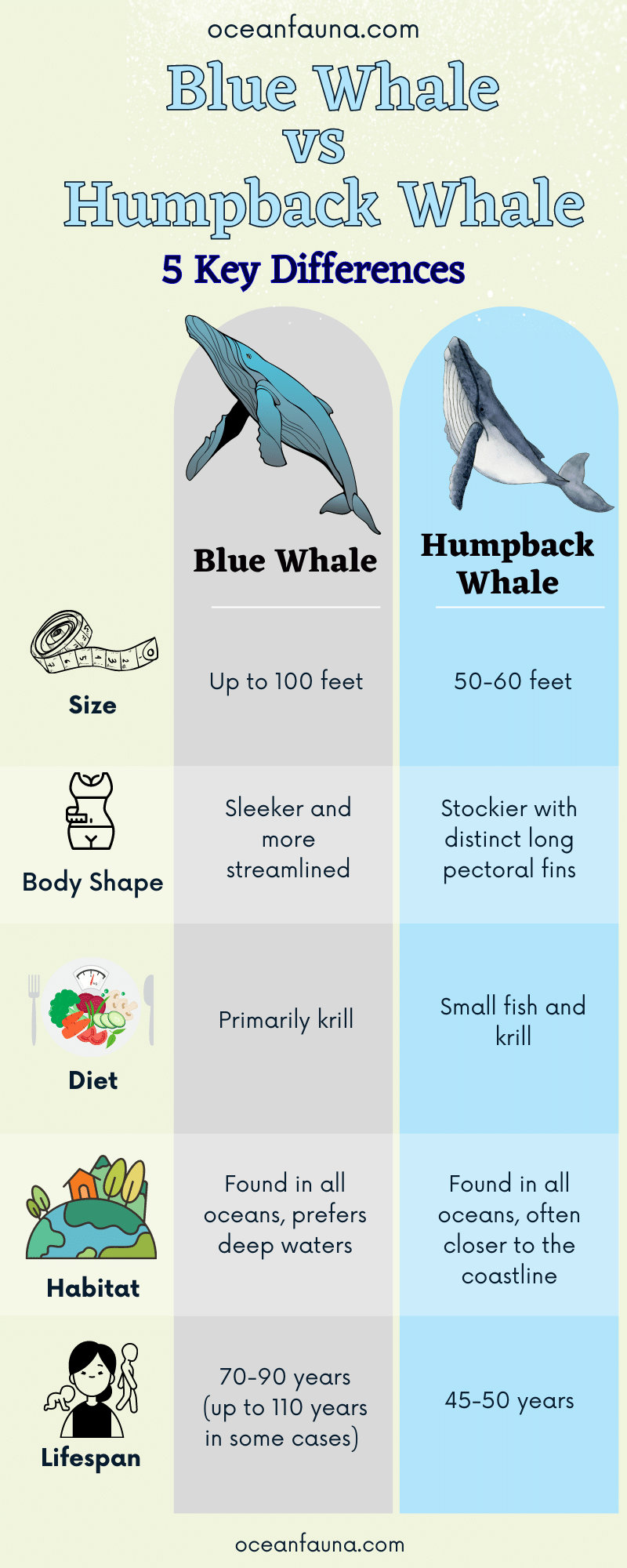
Although they might seem similar at first glance, when you look a bit closer, a whole new world of differences comes to light. Each of these whales carries its own set of secrets, unique behaviors, and a lineage that spans millions of years.
Stay with us to dive deeper into the mesmerizing universe of these oceanic giants! There’s an ocean of wonder waiting to be explored!
Blue Whale vs Humpback Whale: A Quick Comparison
| Feature | Blue Whale | Humpback Whale |
| Scientific Name | Balaenoptera musculus | Megaptera novaeangliae |
| Family | Balaenopteridae | Balaenopteridae |
| Body Shape | Sleeker and more streamlined | Stockier with distinct long pectoral fins |
| Size | Up to 100 feet | 50-60 feet |
| Diet | Primarily krill | Small fish and krill |
| Habitat | Found in all oceans, prefers deep waters | Found in all oceans, often closer to the coastline |
| Social Behavior | Solitary or in small groups | Solitary, sometimes seen in larger groups |
| Lifespan | 70-90 years (up to 110 years in some cases) | 45-50 years |
| Gestation Period | About 10-12 months | Around 11-12 months |
| IUCN Status | Endangered | Least Concern (but some populations remain at risk) |
Blue Whale vs Humpback Whale: What Are the Key Differences?
Blue whales and humpback whales are both giant wonders of the deep blue. Both of these whales munch mainly on krill with their filter-feeding skills. They are skilled swimmers with bodies made for speed and the strength to dive deeply into the ocean.
But despite these resemblances, they are pretty distinguishable. Want to know how? Let’s look closer and learn what makes these two whales distinctive.
1. Taxonomy and Scientific Classification
The blue whale and the humpback whale both belong to the same order Cetacea and the family Balaenopteridae. But they diverge significantly at the genus and species levels.
Blue Whale
The blue whale (Balaenoptera musculus) stands as the most gigantic animal on the planet. It belongs to the Mysticeti sub-order, which is a group of baleen whales.
What makes baleen whales special? Instead of teeth, they have baleen plates, which they use to filter feed. ~Source
There are multiple subspecies of blue whales around the world:
- Northern blue whale
- Antarctic blue whale
- Northern Indian Ocean blue whale
- Pygmy blue whale
- Chilean blue whale
Humpback Whale
Like the blue whale, humpback whales (Megaptera novaeangliae) are also baleen whales, falling under the Mysticeti sub-order.
They belong to the family Balaenopteridae too, but their genus is Megaptera, distinguishing them from the blue whales.
Megaptera translates to “big-winged,” referring to their large pectoral fins. The species name, novaeangliae, means “of New England.” This was named for the location where the type specimen was described. ~Source
| Taxonomic Rank | Blue Whale | Humpback Whale |
| Class | Mammalia | Mammalia |
| Order | Cetacea | Cetacea |
| Suborder | Mysticeti | Mysticeti |
| Family | Balaenopteridae | Balaenopteridae |
| Genus | Balaenoptera | Megaptera |
| Species | B. musculus | M. novaeangliae |
Also Read: Sperm Whale vs Orca: Key Differences Explained
2. Habitat and Distribution
While they may sometimes share the same waters, the specific habitats and distribution patterns showcase the incredible adaptability of these gentle giants.
Blue Whale
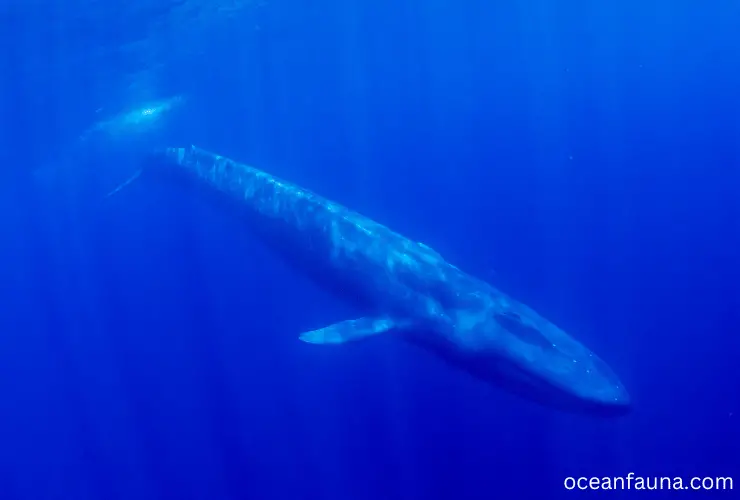
Blue whales have a global distribution residing in every ocean but the Arctic. They prefer deep, open ocean waters rather than coastal regions. They are usually found in waters over 200 meters deep, which offers them ample space and the right environment to hunt for their favorite food.
- The Antarctic blue whale is mostly found in the Southern Hemisphere, particularly in the Antarctic waters during summer, migrating to more temperate and tropical waters during winter.
- The Northern blue whale frequents the North Atlantic and North Pacific oceans.
- Other subspecies, like the Pygmy blue whale, prefer the waters of the Indian Ocean and the South Pacific. ~Encyclopedia of Marine Mammals (Second Edition)
Humpback Whale
Humpback whales are also globally distributed. They are found both in deep oceanic waters and shallow coastal regions.
- In the summer, they feed in high-latitude regions like the Antarctic and Arctic.
- During winter, they migrate to warmer tropical and subtropical waters for breeding. This migration can cover distances of over 8,000 kilometers round-trip, one of the longest migrations of any mammal. ~National Geographic
| Factor | Blue Whale | Humpback Whale |
| Habitat | Deep, open ocean waters over 200 meters deep. | Both deep oceanic waters and shallow coastal regions. |
| Distribution | Global. In every ocean except the Arctic. Linked to prey availability. | Global. High-latitude regions for feeding and tropical waters for breeding. |
3. Physical Appearance
Though blue whales and humpback whales share the same blueish oceanic waters, they have distinguishing features that set them apart.
Blue Whale
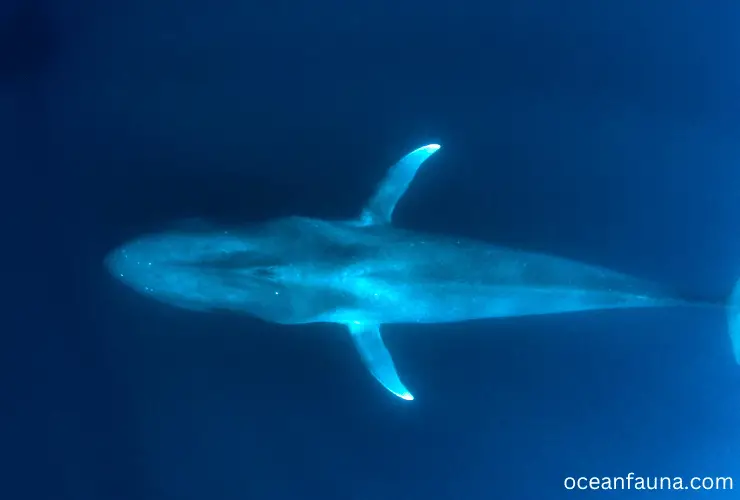
- Size: As the largest animal on Earth, adult blue whales can be up to 100 feet long and weigh nearly 200 tons. Just to give you an idea, their heart alone can be as big as a small car!
- Color: They are a mottled bluish-grey with a lighter underside. This coloration helps camouflage them in the oceanic depths.
- Body: Blue whales have a relatively slender body compared to other whales, which is streamlined for efficient swimming.
- Fins and Flukes: They have a small dorsal fin located near the tail. Their flippers are long and pointed, while their tail flukes are wide and triangular.
- Head: Their head is broad and flat, making up about one-fourth of their total body length. ~Source
Humpback Whale
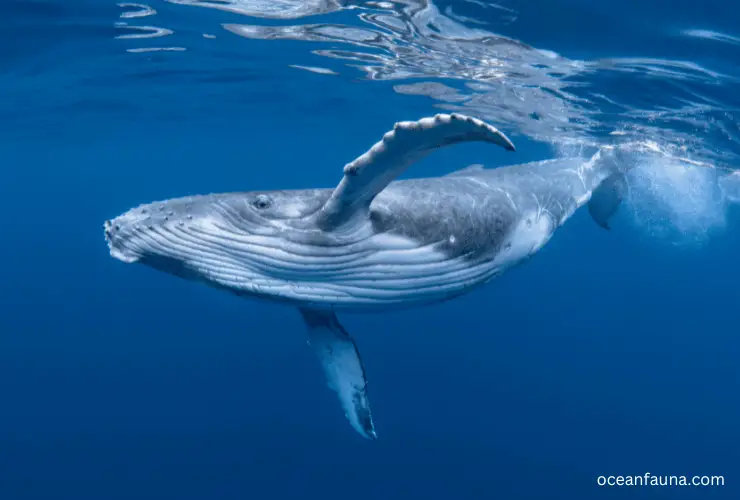
- Size: Humpbacks are large but not as gigantic as blue whales. They typically range from 40-60 ft long and weigh around 40 tons.
- Color: These whales have a dark back and a lighter belly. Some have white patterns on their flukes and flippers, which are unique to each whale, much like our fingerprints!
- Body: Their bodies are robust and less streamlined than the blue whale. They have distinctive bumps or tubercles on their head and jaws.
- Fins and Flukes: One of the most distinguishing features of the humpback is its long pectoral fins, which can be about a third of its body length. Their tail flukes are broad with a serrated trailing edge and can be raised high during dives.
- Head: Their head is broad with a series of large bumps or knobs. ~Alaska Department of Fish and Games
| Feature | Blue Whale | Humpback Whale |
| Size | Up to 100 feet, 200 tons | 40-60 feet, around 40 tons |
| Color | Mottled bluish-grey with a lighter underside | Dark back, lighter belly, unique white patterns on flukes and flippers |
| Body Shape | Slender and streamlined | Robust with bumps on head and jaws |
| Fins & Flukes | Small dorsal fin, long pointed flippers, broad triangular tail flukes | Long pectoral fins, broad tail flukes with serrated edge |
| Head | Broad and flat | Broad with large bumps or knobs |
4. Diet and Feeding Habits
Though humongous in size, these whales have distinct diets.
Blue Whale
Blue whales, despite being the largest animals on Earth, rely on some of the tiniest marine creatures for sustenance. Their primary diet consists of tiny shrimp-like animals, i.e., krill. At certain times, they might also consume copepods, another small crustacean.
Blue whales are baleen whales, meaning they possess comb-like plates (made of baleen) in their mouths. These plates help them filter their tiny prey from the ocean water.
- They typically gulp large amounts of water rich in krill, then push the water out of their mouths using their massive tongues. The krill get trapped in the baleen, and the whale then licks off and swallows its catch.
- As per the American Cetacean Society, a hungry blue whale can eat up to 4 tons of krill in a single day!
Humpback Whale
While krill is also on their menu, humpbacks have a broader palate. They feed on a mix of krill and small schooling fish like herring, anchovies, capelin, pollock, haddock, mackerel, salmon, and various other fish.
Like the blue whale, humpbacks are also filter feeders with baleen plates. But they employ a unique method called bubble net feeding:
A group of humpbacks will dive down and locate a school of fish, as detailed in the journal article Behavior. One or a few whales will then blow a series of bubbles while swimming in an upward spiral. This “net” of bubbles confuses and traps the fish.
Other group members will then swim up through this “bubble net” with their mouths wide open, gulping down the trapped fish. It’s a fascinating team effort, displaying their intelligence and coordination.
| Feature | Blue Whale | Humpback Whale |
| Primary Diet | Krill (occasionally copepods) | Krill and small schooling fish (herring, anchovies) |
| Feeding Mechanism | Baleen filter feeding. | Baleen filter feeding & unique “bubble net feeding.” |
| Daily Consumption | Up to 4 tons of krill | Varied, but can be several tons of food |
5. Social Behavior
Both blue and humpback whales traverse the same vast oceans, but their social interactions and behaviors paint distinct portraits of their lives beneath the waves.
Blue Whale
- Group Structure: Blue whales are largely solitary creatures. They’re often seen alone or in small groups, typically consisting of two to three individuals. Larger aggregations can form in regions with abundant food, but these groups are loose and temporary.
- Vocalizations: Blue whales are known for their low-frequency calls (pulses, groans, and moans). These calls can be heard over vast distances, possibly serving as a means of communication, navigation, or even mating rituals.
- Mating and Bonding: They don’t form long-term bonds with mates and have a rather elusive courtship behavior. ~Source
Humpback Whale
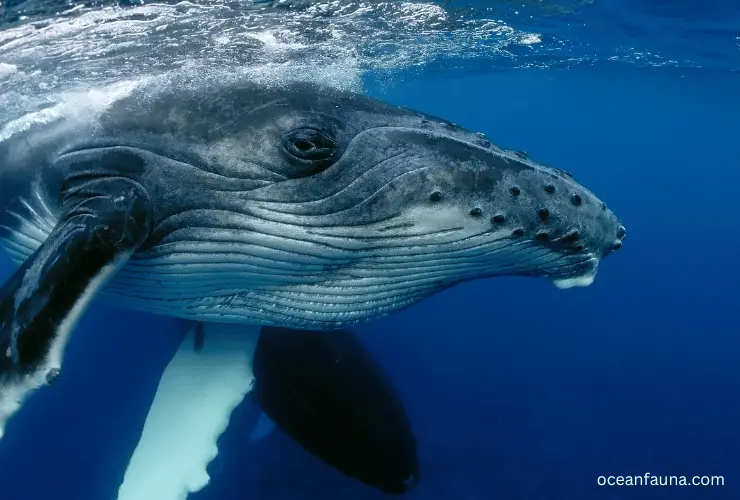
- Group Structure: Unlike the solitary blue whale. While they don’t have permanent pods, they can form temporary groups, especially during feeding or migration. As detailed in Molecular Ecology, these groups can vary from a few individuals to larger congregations.
- Vocalizations: Humpbacks are famous for their “songs,” complex series of moans, howls, and screams that can continue for hours.
- Mating and Bonding: They have a more observable mating behavior, with males competing for females by displaying various behaviors like breaching or tail-slapping. However, like blue whales, they don’t form long-term bonds with their mates.
- Unique Behaviors: Humpbacks are known for their acrobatics. Breaching (leaping out of the water) or slapping the surface with their fins or tails might be a way of communication, removing parasites, or just plain fun!
| Feature | Blue Whale | Humpback Whale |
| Group Structure | Solitary or in small groups | Temporary groups, more gregarious |
| Vocalizations | Low-frequency calls | Complex “songs” |
| Mating & Bonding | Elusive courtship, no long-term bonds | Competitive displays, no long-term bonds |
| Unique Behaviors | None particularly distinctive outside of vocalizations | Acrobatics like breaching, tail-slapping |
6. Reproduction and Lifecycle of whales
These whales also have somewhat unique reproduction cycles.
Blue Whale
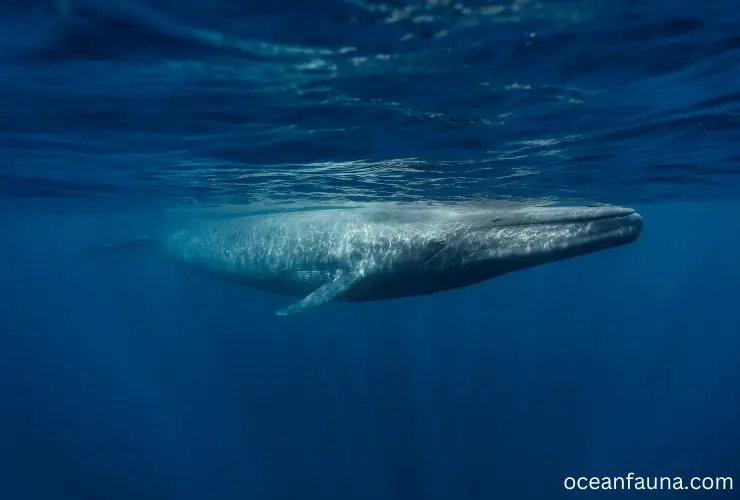
- Mating: Blue whales typically mate during the winter months. Unlike some animals, they don’t have specific breeding grounds but rather mate in warmer waters.
- Gestation: After mating, the gestation period lasts about 10-12 months. Blue whales, like other mammals, give live birth.
- Calving: Blue whale calves are born in warmer, tropical waters. At birth, a blue whale calf can be up to 25 feet long and weigh around 3 tons.
- Nursing and Growth: A blue whale calf drinks up to 150 gallons of its mother’s rich milk every day, leading to a daily weight gain of over 90 kg. Nursing lasts for about 6-7 months, after which the calf starts to feed on krill.
- Maturity: Blue whales get sexually mature between 5-10 years. They can live around 70 to 90 years, although some have been reported to reach 100 years, as documented by Subhrajit Chakraborty.
Humpback Whale
- Mating: Humpbacks have specific breeding grounds, often migrating thousands of miles to mate and give birth in tropical or subtropical waters.
- Gestation: Once impregnated, a female humpback carries her calf for about 12 months.
- Calving: Humpback calves, born in the safety of shallow waters, measure about 10-16 feet at birth and weigh up to 1 ton.
- Nursing and Growth: Humpback mothers nurse their calves for nearly one year. The calf consumes 100 to 130 gallons of milk daily, helping it grow rapidly.
- Maturity: Humpbacks attain sexual maturity between 6-10 years of age and have a lifespan ranging from 80 to 90 years. ~American Cetacean Society
| Feature | Blue Whale | Humpback Whale |
| Mating Location | Warmer waters, no specific breeding grounds. | Specific breeding grounds in tropical/subtropical waters. |
| Gestation | 10-12 months | 11-12 months |
| Calf Size at Birth | Up to 25 feet and 3 tons | 10-16 feet and up to 1 ton |
| Nursing Duration | About 6-7 months | Almost a year |
| Maturity Age | 5-10 years | 4-7 years |
| Lifespan | 70-90 years (sometimes 110 years) | 80 to 90 years |
7. Natural Predators
Even giants like blue and humpback whales aren’t entirely without threats.
Blue Whale
One of the few known predators of blue whales, especially the calves, is orcas. While adult blue whales often have the size advantage, orcas hunt in pods and use coordinated attacks, making them a significant threat to younger whales. ~IWC Journal of Cetacean Research and Management
Humpback Whale
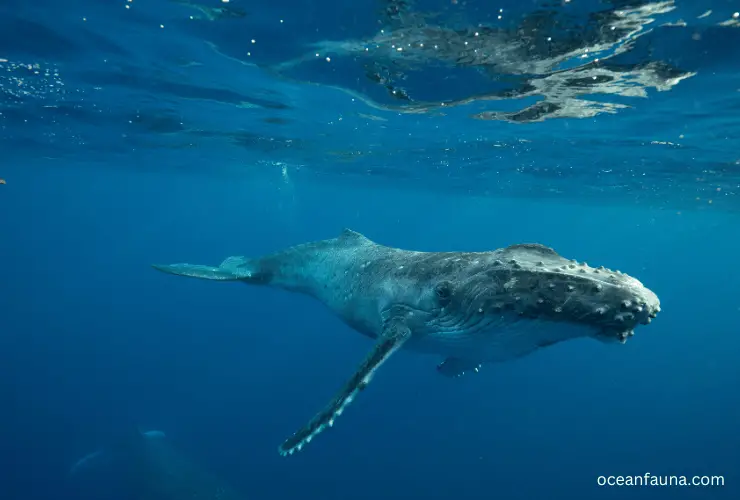
Humpback calves, like blue whale calves, are vulnerable to orca attacks. With their agility and strong flippers, Humpback adults can sometimes fend off orca pods, but the young are at risk.
While not common, there have been instances of large sharks (like the great white) attacking humpback calves. However, it’s not a frequent occurrence. ~Marine Mammal Science
| Species | Marine Predators |
| Blue Whale | Orcas (mainly targeting calves) |
| Humpback Whale | Orcas (especially targeting calves), some large sharks |
8. Defense Mechanism
Both blue and humpback whales have evolved unique defense mechanisms to ensure their survival.
Blue Whale
For the largest animal on Earth, the blue whale’s defense mechanisms are relatively straightforward:
- Speed: Blue whales, despite their massive size, can reach speeds up to 20 mph when threatened. This burst of speed can help them distance themselves from potential threats, especially orcas.
- Sheer Size: The enormous size of an adult blue whale can be intimidating, and most predators would think twice before taking on a full-grown blue whale.
- Travel in Depths: Blue whales often traverse deeper waters, making it harder for potential threats to approach them without being noticed.
Humpback Whale
Humpbacks employ a more dynamic set of defense strategies:
- Tail Slap: Humpbacks are known for their powerful tails. When threatened, they can deliver a powerful slap with their flukes, a formidable deterrent for approaching predators like orcas or sharks.
- Breaching: This act of leaping out and crashing back into the water can serve multiple purposes. Apart from communication, it can also act as a warning or a means to deter potential threats.
- Protective Pods: When orcas threaten humpback calves, adult humpbacks are known to form protective pods around the young, shielding them from the attackers.
- Pectoral Fin Slaps: The humpback’s long pectoral fins can also be used to deliver strong, whipping slaps to deter predators. ~Marine Mammal Centre
| Defense Mechanism | Blue Whale | Humpback Whale |
| Speed and Agility | Can reach speeds up to 20 mph | Uses agility, especially tail and fin slaps |
| Physical Deterrent | Massive size | Powerful tail and pectoral fins |
| Behavioral Defense | Travels in deeper waters | Breaching, protective pods around calves |
9. Interaction With Humans
Both blue whales and humpbacks have a long history of interactions with humans.
Blue Whale
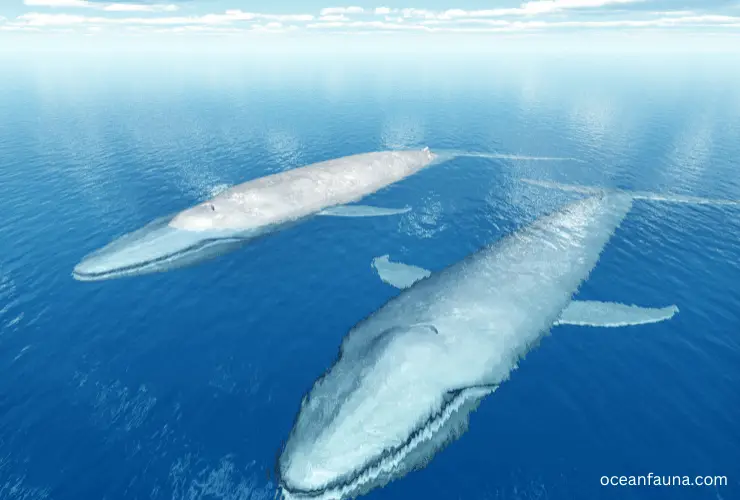
The blue whale was heavily hunted during the 19th and 20th centuries. They were sought after for their oil, meat, and baleen.
Today, many people venture out on boats hoping to glimpse the majestic blue whale. Though they are more elusive than other species, sighting them is a life-changing experience for many.
Humpback Whale
Like the blue whale, humpbacks were a target for whalers due to their size and slow swimming pace. These whales are a favorite for whale watchers. Their curious nature, playful breaching, and mesmerizing songs make them a star attraction in many coastal areas worldwide.
While humpbacks are generally curious and often approach boats, there have been instances where they exhibit protective behavior around humans. Some divers recount stories of humpbacks shielding them from potential shark threats.
| Human Interactions | Blue Whale | Humpback Whale |
| Historical Hunting | Heavily hunted until 1966 | Targeted until the 1980s |
| Whale Watching | Elusive but sought after by watchers | Popular due to acrobatics and songs |
| Behavior Around Humans | Generally distant | Curious, occasionally protective of humans from sharks |
10. Threats and Conservation Status
Despite their colossal size, both these whales face significant threats from the environment and, sadly, from us humans.
Blue Whale
Blue whales were drastically hunted in the 1900s, leading to a substantial drop in their numbers, as described in the Encyclopedia of Biodiversity (Second Edition).
Whaling once pushed blue whales to the brink of extinction. Despite a ban in 1966, their population hasn’t fully recovered. Other threats include:
- Ship Strikes
- Entanglement
- Noise Pollution
- Climate Change.
The IUCN classifies the blue whale as Endangered.
Humpback Whale
Humpbacks, too, suffered heavily from whaling, causing a significant decline in their populations until the mid-20th century.
Like the blue whale, they also face threats from
- Ship Strikes
- Habitat Degradation
- Climate Change.
The IUCN classifies the humpback whale as the ‘Least Concern.’ However, some specific populations remain at risk.
| Category | Blue Whale | Humpback Whale |
| Major Threats | Historical Whaling, Ship Strikes, Entanglement, Noise Pollution, Climate Change | Historical Whaling, Entanglement, Ship Strikes, Habitat Degradation, Climate Change |
| IUCN Status | Endangered | Least Concern (but some populations remain at risk) |
Wrapping Up
So, are Blue Whale and Humpback Whale the same? Nope! Both are incredible giants of the sea and members of the Balaenopteridae family, but they’re quite distinct from one another.
Blue whales are renowned for their immense size and echoing calls, while humpbacks are famous for their playful jumps and complex tunes. While they might swim in the same big blue, their personal characteristics and stories set them apart.
We hope this blog has helped you differentiate between the two mighty whales. Dive into our other blogs to continue your journey of discovery and wonder!

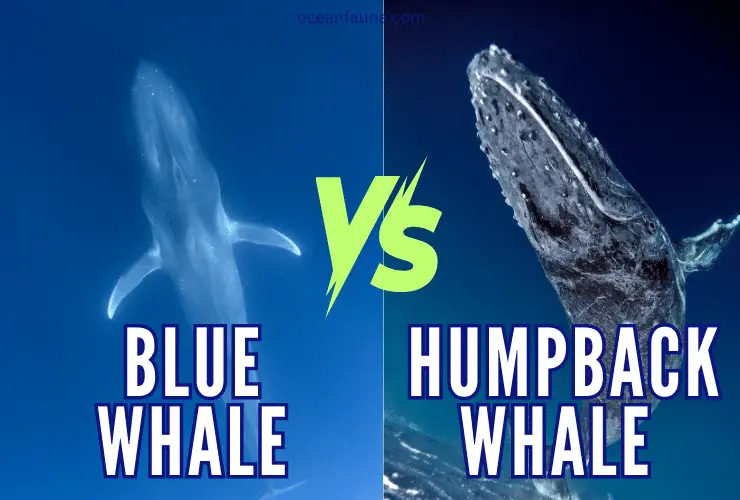
3 thoughts on “Blue Whale vs Humpback Whale: Key Differences Explained”